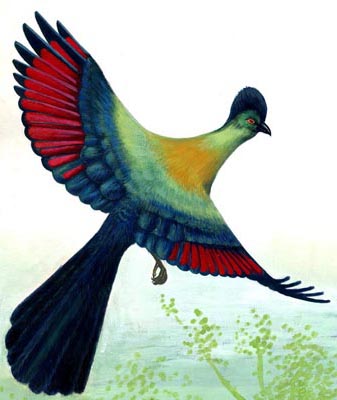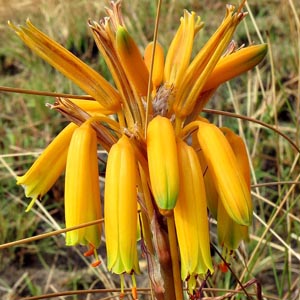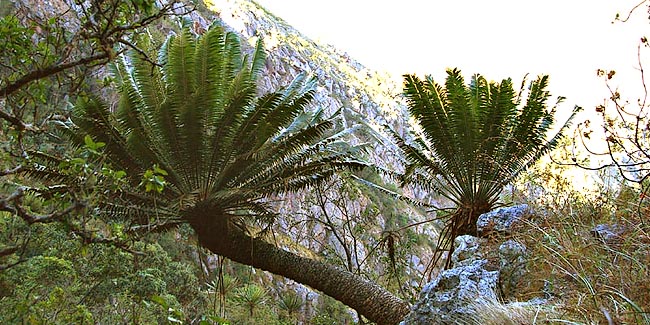The ENTC now has a new website, at www.entc.org.sz
Our logo is adapted from a painting by Phillip Dlamini, 1998, of a purple crested turaco. In traditional Swazi dress, the red feathers feature in the royal headdress, so this bird illustration is not only a symbol for wildlife conservation, but also of cultural heritage.



(Information adapted from "A Bird Checklist for Malolotja Nature Reserve".)
The topographic and climatic variations combine to make the vegetation varied and complex.
(a) Highveld Grassland.
(i) Grassland with the majority of grasses being less than 50cm high. Most of the park over 1 220m. is comprised of this. Typical grasses include Themeda triandra, Tristachya leucothrix, Loudetia simplex, Eragrostis racemosa, E. capensis, Panicum natalensis, Rendlia altera, Monocymbium ceresiiforme, Andropogon filifolius and A. amplectens. This area cover more than 50 of the park.
Termite mounds and old field sites are colonised by the grasses Cynodon dactyton, Paspalum species and Eragrostis plana.
(ii) Medium to tall grassveld with most grasses being over 50cm high. These are found in moist sites in valleys and along valley sides at slightly lower altitudes. Common grasses are Cymbopogon, Hyparrhenia and Setaria sp.
(b) VIeis, Upland Rivers and Dams.
Areas of mixed herbs and woody species and a great variety of plants. Soils are normally waterlogged. In some localities Cliffortia serpyllifolia, Hypericum revolutum, Cyathea dregei (tree fern) and Syzygium cordatum are dominant. The main Malolotja Vlei is a large herbaceous bog with a great variety of grasses, sedges and perennials, intermixed with bulbous plants.

(c) Protea Veld
Large areas of Protea woodlands with trees spaced 30m apart. Predominant species are Protea caffra, P. roupelliae, P. gaguedii, P. welwitschii and P. comptonii, with short montane grassland.
(d) Rocky Hillsides with Scattered Trees
There are many areas scattered throughout the park where rocky outcrops afford protection from fire to a variety of woody and herbaceous plant species. In some instances small, isolated forests are formed. Dominant trees are Buddleia salvifolia, Cephalanthus natalensis, Cussonia spicata, Diospyros whyteana, Ficus species, Halleria lucida, Greyia sutherlandii, Rapanea melanophloeos, Psychotria capensis, Burchellia bubalina and Bequaertiodendron megalismontanum. Other plants are Streptocarpus dunnii, S. cyaneus, Scadoxus carneus, Xerophyta retinervis, Aloe chortolirioides var boastii, A. marlothii and A. arborescens.

(e) Forested Gorges
These forested gorges occur in all the sheltered valleys, mountain kloofs and along the major and minor river systems, at all altitudes, e.g. Mgwayiza Cycad Forest at 1 524m and the Maiolotja Falls Forest at 854m. There is aiso a variation in vegetation species. However the forests are all very similar in structure, with the species composition changing with altitude. These areas extend down the valleys and intergrade with the lower woodlands and thickets where the riverine aspect of the woodland thicket habitat extends upwards. In places the larger trees form impressive canopies. Dominant trees are Syzygium cordatum, Dalbergia armata, Harpephyllum caffrum, Heteropyxis canescens, Strelitzia caudata, Rapanea melanophloeos, Combretum krausii and Zanthoxylum davyi. Along the rivers at lower altitudes, Breonadia salicina and Anthocleista grandiflora are common. On east facing slopes at high altitudes, large stands of the Barberton cycad Encephalartus paucidentatus can be found, e.g. Mgwayiza cycad forest. E. laevifolius, the Kaapsehoop cycad, tends to grow on the edges of the forests.
(f) Mixed Woodlands, Thickets and Thornveld
These occur in various forms according to altitude, slope, soil depth and aspect, and are generally found below 915m. They are thus only associated with the lower Malolotja, Nkomati and Mgwayiza Valleys. Species composition of the woodland varies from the Malolotja Valley to the Nkomati Valley. Some of the typical tree species found in the higher alitude woodlands are Faurea speciosa, Dombeya rotundifolia, Erythrina lysistemon and Bequaertiodendron megalismontanum. Along the Malolotja valley are Syzygium cordatum, Peltophorum africanum, Heteropyxis natalensis, Breonadia salicina, Dombeya pulchra, Pavetta edentula and Acacia ataxacantha. Much of the flatter areas were cleared for cultivation and are now regenerating particularly with Pterocarpus angolensis and Acacia davyi.
In the Nkomati valley woodlands there is a much greater occurence of middleveld and lowveld species, e.g. Antidesma venosum, Ziziphus mucronata, Annona senegalensis, Dichrostachys cinerea, Bauhinia galpinii, Ficus capensis and Combretum and Stychnos species. Cymbopogon, Hyparrhenia and Setaria grass species are dominant.
The thickets are characterised by the above species as well as Dalbergia armata, Grewia occidentalis and Acacia ataxacantha.
(g) Rock/cliff faces
A distinctive flora occurs on the almost precipitous rock faces, e.g. Aloe suprafoliata, A. sessiliflora and A. arborescens, Streptocarpus cyanescens, Crassula and Kalanchoe species, and on some rock faces, the Barberton cycad Encephalartos paucidentatus.

(h) Nkomati River
The Nkomati River is characterised by reedbeds of Phragmites australis and large Ficus capensis and Breonadia salicina trees. It has large sandbanks and pools interspersed with rapids, and flows through two gorges. On the banks grow a number of exotic trees and weeds, in particular Lantana camara, Solanum mauritianum (Poison Apple) and Ricinus communis (the castor oil plant).
(i) Exotic Forests and Thickets
(i) Forests
There are a number of exotic forests throughout the nature reserve. All are related to old mines, homesteads etc. and are comprised of large stands of wattle Acacia mearnsii and A. decurrens, Blackwood (Acacia melanoxylon) and Eucalyptus species.
Other exotics include Pinus species and scrambling plants such as Rubus niveus.
(ii) Thickets
Old kraal sites support very dense thickets of indigenous Solanum acanthoideum, S. giganteum, Lippia javanica and various planted exotics.
Our Contacts:
Head Quarters: (+268) 2416 1489/1179
Email: info@sntc.org.sz
King Sobhuza II Park: (+268) 2416 1489/1179
Email: ksmp@sntc.org.sz
National Museum: (+268) 2416 1489/1179
Email: curator@sntc.org.sz
Copyright © ESWATINI NATIONAL TRUST COMMISSION
Malolotja Nature Reserve: (+268) 2444 3241 / (+268) 2416 1480
Email: culturalvillage@sntc.org.sz
Mantenga Nature Reserve and Swati Cultural Village: 2416 1151/1178
Email: culturalvillage@sntc.org.sz
Mlawula Nature Reserve: (+268) 2383 8885 (Reception)
(+268) 2383 8453 (Senior Warden)
Email: culturalvillage@sntc.org.sz
Magadzavane Lodge: (+268) 2343 5108/9
Email: magadzavane@sntc.org.sz